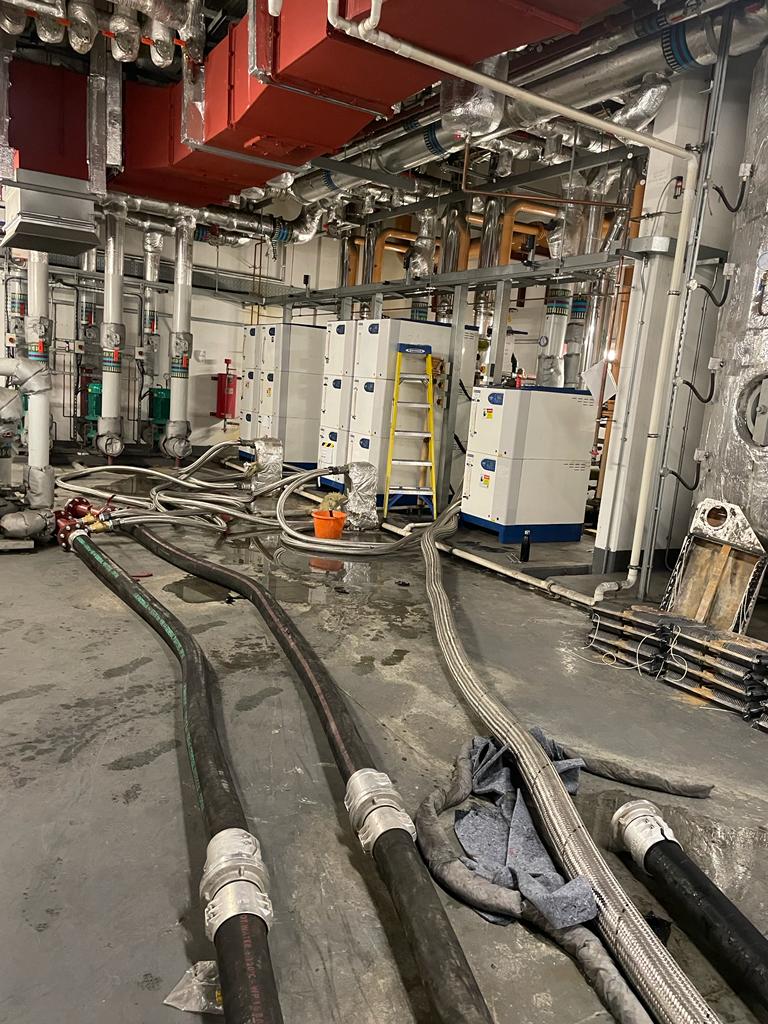
If you’re exploring heating solutions for your commercial or industrial facility, you might have come across the term “boiler plant room.” This integral component of a heating system plays a crucial role in ensuring efficient and reliable heating for your building.
In this guide, we’ll delve into the concept of a boiler plant room, explaining its purpose, components, size considerations, and the difference between a permanent boiler plant room and a packaged boiler.
Boiler plant room explained
A boiler plant room is a designated space within a building that houses central heating equipment, including boilers, piping systems, controls, and safety devices. It serves as the heart of the heating system, where the necessary components work together to generate heat and distribute it throughout the building.
Boiler plant rooms are designed to accommodate various types of boilers and associated equipment, ensuring optimal functionality and safety.
What is inside a boiler plant room?
Inside a typical boiler plant room, you’ll find several essential components that collectively create a functional heating system:
1. Boiler
The primary heating unit that generates hot water or steam, which is then distributed throughout the building.
2. Fuel Supply Lines
These lines connect the boiler to the fuel source, which can be natural gas, oil, or other forms of fuel.
3. Flue Stack
The flue stack expels the combustion gases produced by the boiler, preventing them from entering the building.
4. Piping Systems
Piping systems transport heated water or steam from the boiler to various parts of the building, such as radiators, underfloor heating systems, or air handlers.
5. Controls and Safety Devices
These include thermostats, pressure relief valves, temperature sensors, and other devices that regulate and monitor the heating process to ensure safe and efficient operation.
How big is a boiler plant room?
The size of a boiler plant room can vary significantly based on factors such as the size of the building, the heating load, and the type of equipment installed.
Larger buildings with higher heating demands might require larger plant rooms to accommodate multiple boilers and associated equipment. Conversely, smaller buildings might have more compact plant rooms housing a single boiler.
Difference between a boiler plant room and a packaged boiler
A boiler plant room is a permanent space within a building dedicated to housing heating equipment. It provides a centralised location for heating components to operate efficiently.
On the other hand, a packaged boiler is a self-contained unit that includes the boiler, controls, and sometimes additional equipment, all housed within a single casing. Packaged boilers are typically pre-engineered and can be installed outdoors or indoors.
Benefits of a packaged boiler:
Compact Design
Packaged boilers offer a space-saving solution, making them suitable for buildings with limited space.
Ease of Installation
Packaged boilers are pre-assembled, simplifying the installation process and reducing downtime.
Mobility
Some packaged boilers are mobile and can be transported to different locations as needed.
Efficiency
Packaged boilers are designed for optimal efficiency and performance, ensuring reliable heating.
Hire a packaged boiler with Ideal Heat Solutions
Understanding the concept of a boiler plant room is essential for anyone considering a heating system upgrade for their commercial or industrial facility. A well-designed boiler plant room ensures efficient heating operations by housing essential components like boilers, fuel supply lines, piping systems, controls, and safety devices.
Additionally, considering the benefits of packaged boilers can help you make an informed decision based on your building’s requirements.
And if you’re interested in maintaining your boiler system, read about Boiler Maintenance and Contingency Planning. With a comprehensive understanding of boiler plant rooms and packaged boilers, you’re better equipped to make the right heating decisions for your facility.
FAQs about boiler plant rooms
Do CO2 detectors need fitting in gas boiler plant rooms?
Yes, fitting CO2 detectors in gas boiler plant rooms is a safety requirement to monitor and detect potentially harmful levels of carbon dioxide.
What is the difference between a boiler plant room and a plant room?
While a boiler plant room is specifically designed to house heating equipment, a plant room can encompass various utility systems, including electrical, mechanical, and plumbing components.
Is it safe to be in a boiler plant room?
Boiler plant rooms should only be accessed by trained personnel who understand the safety protocols associated with heating equipment. Adequate ventilation, proper safety gear, and adherence to guidelines ensure a safe environment.